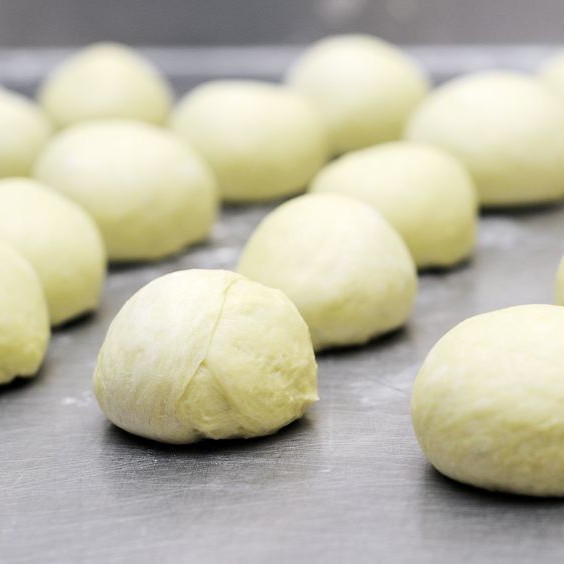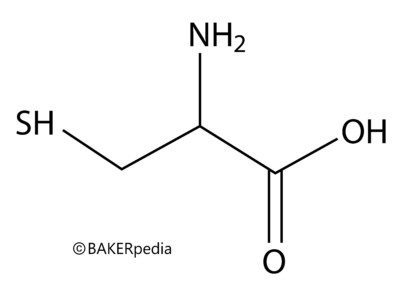
L-Cysteine
What is L-Cysteine?
L-Cysteine is an amino acid that serves as a building block of some proteins. It is one of the most common reducing agents in baking, as well as in enriched beef flavors.
In commercial baking, l-Cysteine offers many benefits:1
- Gluten softening and dough relaxing
- Dough conditioning
- Reduced mixing and fermentation times
- Better dough consistency and easier handling
- Improved pan flow
Origin
Foods rich in l-Cysteine have been known for their health benefits since the Middle Ages. Chicken macerates containing it were often used to treat asthma. Drugs based on derivatives are still used today for asthma and other chronic obstructive pulmonary diseases (COPD).
While l-Cysteine can be derived from animal and even human sources such as goose and duck feathers, human hair, swine bristles, and hooves, there is also a well-established fermentation process using plant starch as raw material.1

- Chemical structure of L-Cysteine.
Commercial production
The traditional production process for l-Cysteine starts with boiling the raw material (feathers or hair) in concentrated hydrochloric acid and activated carbon. Then, this is followed by electrolysis.2 One of the drawbacks of this approach is the need for huge amounts of concentrated sulfuric acid and water. Also, the finished product is not ‘kosher’ or ‘halal’ and is unsuitable for vegan diets.
A more sustainable fermentation process for producing vegan l-Cysteine and l-Cystine (a dimer of l-Cysteine) has been introduced. This uses plant-based raw materials such as corn and inorganic trace elements.2 This method is more sustainable compared to the chemical extraction that uses large amounts of acid.
Nutrition
L-Cysteine is a semi-essential amino acid. It is abundant in many foods such as beef liver, crab cakes, lima beans and some mushrooms. It is also a component of many dietary supplements preparations.
As a reducing agent, it may help prevent exercise-induced overproduction of free radicals. This reduces oxidative stress.
Function
In dough, l-Cysteine acts as a reducing agent that helps break down gluten proteins. This dough softening effect is especially valuable in high-protein flours which often produce dense crumb and low volume products. In high-speed bread systems, l-Cysteine has the following benefits:3
- Compensation for high-protein flours
- Shorter mixing times
- Lower dough temperature
- Less stressed dough
- Extensible dough that is more flexible for dividing and rounding
- Less wear and tear on equipment
- Better (pan) flow
- Improved tolerance and less toughening during proofing
- Uniform products
- Higher volume because of facilitated rising
Benefits of Dough Softening
| Wheat Flour | Kneading | Shaping | Proofing and Baking | End Product |
| Compensates too strong of flours with high protein contents |
|
|
|
|
Application
Incorporating reducing agents such as this one to baked goods is essential for products made with high extraction flours. As well as, those processed in one bowl such as bread making machines.4
Sorghum-containing baked goods may benefit from the addition of l-Cysteine addition to improve their viscoelastic properties, reduce firmness and improve their digestibility.
When using high levels of this ingredient, there is the potential development of sulfurous taste and aroma.
Regulations
- L-Cysteine is classified as GRAS by the FDA under Title 21, section 184.1271.5 It is also approved in Canada, Australia, New Zealand and Europe as E920 (EFSA regulation number 1129/2011).6
- Usage in foods is approved in the US and Canada for up to 90 ppm (0.009 parts per 100 parts flour), although practically used at 20 – 30 ppm.
- Kosher labeling of l-Cysteine is allowed only if proper kosher methods are used in its production including no animal sacrifice.
References
- Baking Association of Canada. “L-CYSTEINE,” http://www.baking.ca/Food%20and%20Nutrition%20Policy%20Revised/L-cysteine.pdf
- Hiroyuki, K., et al. “Process for Producing L-lysine by Fermentation.” 15 June 1995..
- US Food and Drug Administration. CFR – Code of Federal Regulations Title 21. Accessdata.fda.gov, www.accessdata.fda.gov/scripts/cdrh/cfdocs/cfcfr/cfrsearch.cfm?fr=184.1271.
- Stoica, A., Popescu, C., Barascu, E. and Lordan, M. L-cysteine influence on the physical properties of bread from high extraction flours with normal gluten. Annals Food Sci. Technol., 2010, vol 11, No. 2, pp. 6-10.
- BAKERpedia. “Dough Conditioner Ingredients” | Baking Ingredients, bakerpedia.com/ingredients/dough-conditioner-ingredients/.
- COMMISSION REGULATION (EU) No 1129/2011 of 11 November 2011 amending Annex II to Regulation (EC) No 1333/2008 of the European Parliament and of the Council by establishing a Union list of food additives.

